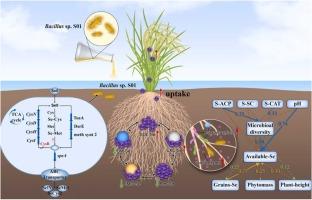Selenium solubilization by Bacillus sp. S01: Mechanistic insights and environmental implications in paddy soils
IF 11.3
1区 环境科学与生态学
Q1 ENGINEERING, ENVIRONMENTAL
引用次数: 0
Abstract
Selenium (Se) is an essential micronutrient for humans, and crop Se biofortification presents a global health strategy to ensure safe dietary Se intake. However, low Se bioavailability in paddy soils limits Se uptake by rice (Oryza sativa L.), hindering agronomic Se biofortification. Although microorganisms play a pivotal role in mediating Se transformation within soil biogeochemical cycles, the underlying mechanisms remain to be fully elucidated. In this study, a Se-tolerant bacterium, Bacillus sp. S01, was isolated from high-Se soil and demonstrated the ability to convert Se(0) into bioavailable Se species. Integrated metabolomic and genomic analyses putative Se(0)-solubilizing genes in strain S01, including sulfur assimilation-related genes (gene1757, gene2869, and gene1971). Heterologous expression confirmed that gene1757, gene2869, and gene1971 enhanced Se(0) dissolution in Escherichia coli. Soil microcosm and pot experiments revealed that inoculation with strain S01 increased soluble and exchangeable Se fractions while reducing residual Se content. Additionally, it significantly improved soil pH, enzyme activities (sucrase, acid phosphatase, catalase, urease), and reshaped the rhizosphere microbial community, with Bacillus, Fonticella, and Lutispora identified as key taxa driving Se activation and bioavailability. These changes collectively enhanced rice biomass, yield, and enhanced grain Se content by 91 %. In summary, strain S01 likely transform Se(0) into bioavailable forms via sulfur metabolism pathways while improving Se bioavailability through modulation of soil properties and rhizosphere microbiota. These findings advance our understanding of microbial Se cycling and highlight the potential of Se-solubilizing bacteria in sustainable Se biofortification.

芽孢杆菌S01对水稻土中硒的增溶作用及其环境意义
硒(Se)是人类必需的微量营养素,作物硒生物强化是确保膳食硒安全摄入的一项全球健康战略。然而,水稻土壤低硒生物有效性限制了水稻对硒的吸收,阻碍了农艺硒生物强化。虽然微生物在土壤生物地球化学循环中介导硒转化中起着关键作用,但其潜在机制仍有待充分阐明。在本研究中,从高硒土壤中分离到一种耐硒细菌芽孢杆菌S01,并证明了将Se(0)转化为生物可利用的Se物种的能力。综合代谢组学和基因组学分析推测菌株S01中存在硒(0)溶解基因,包括硫同化相关基因(基因1757、基因2869和基因1971)。异源表达证实,基因1757、基因2869和基因1971增强了Se(0)在大肠杆菌中的溶出。土壤微观和盆栽试验表明,接种菌株S01提高了土壤可溶性和交换性硒组分,降低了土壤残余硒含量。此外,它显著改善了土壤pH、酶活性(蔗糖酶、酸性磷酸酶、过氧化氢酶、脲酶),重塑了根际微生物群落,其中芽孢杆菌、Fonticella和Lutispora被确定为驱动硒活化和生物利用度的关键类群。这些变化共同使水稻生物量、产量和籽粒硒含量提高了91%。综上所述,菌株S01可能通过硫代谢途径将Se(0)转化为生物可利用形式,同时通过调节土壤性质和根际微生物群来提高Se的生物可利用性。这些发现促进了我们对微生物硒循环的理解,并突出了硒溶化细菌在可持续硒生物强化中的潜力。
本文章由计算机程序翻译,如有差异,请以英文原文为准。
求助全文
约1分钟内获得全文
求助全文
来源期刊

Journal of Hazardous Materials
工程技术-工程:环境
CiteScore
25.40
自引率
5.90%
发文量
3059
审稿时长
58 days
期刊介绍:
The Journal of Hazardous Materials serves as a global platform for promoting cutting-edge research in the field of Environmental Science and Engineering. Our publication features a wide range of articles, including full-length research papers, review articles, and perspectives, with the aim of enhancing our understanding of the dangers and risks associated with various materials concerning public health and the environment. It is important to note that the term "environmental contaminants" refers specifically to substances that pose hazardous effects through contamination, while excluding those that do not have such impacts on the environment or human health. Moreover, we emphasize the distinction between wastes and hazardous materials in order to provide further clarity on the scope of the journal. We have a keen interest in exploring specific compounds and microbial agents that have adverse effects on the environment.
 求助内容:
求助内容: 应助结果提醒方式:
应助结果提醒方式:


